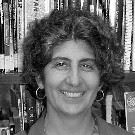 |
| Dr. Ines Cifuentes |
I am a child of two cultures. My father is from Quito, Ecuador, and my mother is Jewish from New York City. Although I was born in London, England, most of my childhood was spent in Latin America. Since both of my parents were economists with the United Nations, my brother and I had the opportunity to live in many different countries including Ecuador, Paraguay, Chile, and Guatemala. Even though I have lived in America from the time that I was twelve years old, Latin America still feels like home and for many years I planned on returning to live there permanently.
Moving to America wasn't easy and I found it very difficult to adjust both socially and academically. Kids at school asked whether we lived in trees in Guatemala. My 7th grade P.E. teacher told me to go take off my stockings when I wasn’t wearing any - it was just the dark color of my skin! As far as academics were concerned, it was challenging to get into the right classes. My school said it wasn’t on the tracking system, but it was obvious that there were low, middle, and high classes. I had to fight to get into the high track math class where I knew I belonged. I had loved math and science ever since I received a book on astronomy from my grandfather when I was seven years old. Thanks to my parents, who valued me for being a girl and being intelligent, I was never faced with the notion that women could not be scientists or mathematicians.
I majored in physics with an emphasis in astronomy at Swarthmore College in Pennsylvania, where I was the only woman in the department. However, in my senior year, I realized that it would be difficult to pursue astronomy in Latin America. I knew that I wanted to balance my love of science with my passion for political work, but I didn’t know how. One of my physics professors encouraged me to apply to graduate school in geophysics, emphasizing that such work could be beneficial in Latin America. I took my professor’s advice, and started my graduate work at Stanford University in geophysics.
After receiving my master’s degree, I was employed by the U.S. Geological Survey doing field research in Guatemala and Nicaragua where I was setting up portable seismographs in rural areas. As it turned out, there was an earthquake while I was there, and because I could speak Spanish, I was able to explain to villagers what we were doing. All of a sudden it felt like I could do science research in Latin America and help people at the same time. However, I realized that in order to do really interesting and beneficial scientific work, I needed to get a Ph.D., because that advanced degree would give me the independence and means to create my own projects.
I enrolled in the Ph.D. program in seismology at Columbia University in New York City where I became very interested in studying the Chilean Earthquake of 1960. At 9.5 on the Richter scale, it is the largest ever-recorded earthquake. It lasted for almost five minutes and created tidal waves as far away as Hawaii! The particularly interesting thing about this earthquake was that an unusual seismic event had been recorded at the California Institute of Technology in Pasadena fifteen minutes before the earthquake struck. My question was whether these events were related or were simply coincidence. After years of research and studying seismographic records from all around the world, I was able to prove that the two events were connected. It was my hope that this work would contribute to the research being done on how to predict earthquakes.
While my research was very fulfilling and exciting, my experience at Columbia was challenging. It was extremely difficult to be the only woman, let alone Latin American in my program. Despite the hardship, I graduated in 1988 and was the first woman to ever earn a Ph.D. in seismology from Columbia!
Although I never made it back to Latin America to live, my life has come almost full circle because I am now working in the Washington D.C. area, including the district where I attended school. Similar to when I was in school, many children are being placed in classes based more on the color of their skin rather than their academic potential. Most of these classes have very poor science, math, and technology programs. In my work as the director for the Carnegie Academy for Science Education in Washington D.C., I teach science and mathematics to elementary school students and educators in the D.C. public schools to try and improve the programs and increase opportunity for the students.
Getting to where I am in life has not been easy, but I have learned to fight my battles and see where I can make a difference. Science has given me a special view of the world. It has taught me to think critically, ask questions, and persevere.
Page created on 7/3/2013 12:44:14 PM
Last edited 1/9/2017 9:53:39 PM
